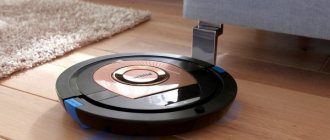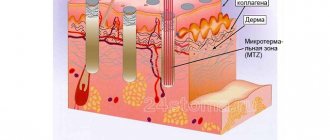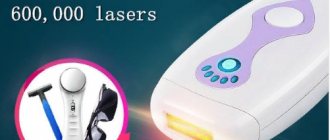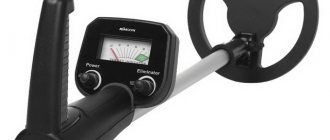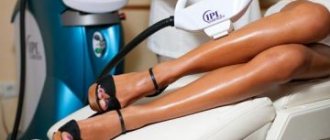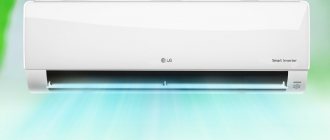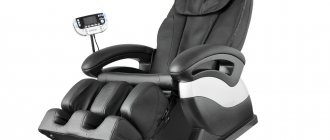All girls have to regularly use a razor or other methods of depilation to remove unwanted body hair. However, there are other methods of removing hair that allow you to enjoy smooth skin for a long time. Knowing what a photoepilator is and the principle of its operation, you can save yourself from the need to frequently remove unnecessary hair.
More information about photoepilators
When talking about what a photoepilator is, you should refer to the procedure for which it is used. Photoepilation is one of the methods for removing unwanted hair from the body, which not only removes hairs with follicles, but also gradually contributes to their death. The effect of this technique lasts for several years.
The principle of operation of the photoepilator is the effect of sharp pulses of light that affect the root system of the hairs.
For a long time it was believed that a photoepilator was a bulky piece of equipment designed for use in a salon, which could only be used by a cosmetologist. However, now smaller versions of the device have appeared that relieve girls of hair at home.
Is there an alternative?
Before you decide to buy a photoepilator, it is worth comparing it with other methods of hair removal at home. Perhaps something different is right for you.
Waxing vs. IPL
Waxing is a painful technique. The hair, of course, thins with each subsequent procedure, but grows back within 3 weeks. Removal occurs quickly, but not all areas of the body are accessible for self-treatment.
For some people, depilation causes subsequent hair growth under the skin. Another disadvantage is the occasional irritation.
For some, it will be unacceptable that for wax depilation you will first need to grow your hair to at least 1 cm long - so that it can be grabbed and removed.
Advantages of household photoepilation over waxing:
- the level of discomfort is significantly lower;
- does not cause ingrown hairs;
- the likelihood of skin inflammation is minimal;
- The frequency of procedures decreases over time.
Shaving versus photoepilation
Shaving takes a lot of time, but hair regrowth after it occurs almost immediately. For those who use this method, the process of removing unwanted vegetation becomes part of daily care.
The procedure is not complete without cuts and rashes - often due to the lack of proper antibacterial treatment of the blade or untimely replacement of a dull instrument. The razor is designed for 5-10 uses, but many people use it for months.
Advantages of photoepilation at home compared to shaving:
- required less frequently;
- no skin irritation;
- safety.
Tweezers or photoepilator?
The mechanical depilatory machine removes even the shortest hairs with a plucking motion. The result lasts about 2 weeks. The more often you practice this manipulation, the less painful it will be - addiction will set in.
However, sometimes the consequences of such a procedure are the ingrowth of the hair shaft under the skin. To achieve perfect smoothness, the process is combined with shaving.
Advantages of home photoepilation compared to mechanical hair removal:
- absence of pain;
- does not provoke ingrown hairs;
- minimal skin irritation.
Laser hair removal (LHR) or IPL technology?
During laser hair removal, the concentrated LHR light beam passing through the skin is converted into heat. The melanin in the hair follicle absorbs it, which ultimately damages the hair root and prevents regrowth. You will need to undergo up to 12 courses of laser hair removal to stop the hair life cycle.
Advantages of household photoepilation compared to laser:
- the process is relatively painless;
- It is more convenient to use on small areas of skin.
Disadvantages of home photoepilation compared to laser exposure:
- inferior in efficiency to LHR beams;
- requires more time to complete the procedure.
How it works?
Photoepilation works by exposing the hair follicles to high-pulse light. To be more precise, the pigment melanin, contained in hair follicles and responsible for the growth and restoration of hairs, absorbs this light. Because of this, the procedure is effective only on dark and light brown hair.
Strong and sudden heating of the hair follicles leads to their spontaneous destruction and death. Because of this, hairs stop growing in the treated area.
The darker the hair in the photoepilation area, the faster and more effectively you can get rid of it. This is due to the large amount of melanin in brunettes compared to girls with light brown hair.
Photoepilation technologies
There are two technologies for photoepilation that are performed in the salon: Elos and IPL. They both ensure total destruction of the hair follicles, but the degree and effectiveness of their impact varies.
How a photoepilator works depends on what technique you choose to remove unwanted hair.
Features of IPL
Classic photoepilation technology, which is based on the work of light pulses emitted by the device. Melanin absorbs these impulses, the hairs overheat and are destroyed. However, keep in mind that for complete hair removal you will have to complete the full course, which can take up to eight months, depending on the area being treated.
The melanin pigment absorbs light impulses in the hair follicle, as well as around it, which ensures total hair removal without the possibility of regrowth in the next few years.
If you want to do the procedure yourself, you should consider how a photoepilator works at home. This is due to the fact that it can have different powers, which is why it is used in different zones.
Elos Features
Modern technology combines two methods of influence: a light pulse and a biopolar electric current. Thanks to this combined effect on vegetation, the device can remove hairs of any color and structure, unlike IPL photoepilation.
The effectiveness of the procedure is also higher than the previous one. So, after performing Elos hair removal, you can enjoy ideal smooth skin for up to 5-6 years.
But take into account the high cost of the procedure itself, as well as the home apparatus for performing it yourself.
Choosing a photoepilator
The modern market offers us several of the most popular manufacturers of photoepilators. You should pay attention not only to the make and model of the device (the principle of their operation is approximately the same), but also to its important technical characteristics.
What is affected by the shape and size of the device?
In general, the size of the device can be compared to the size of a mobile phone, which allows you to take it with you on trips and trips. However, photoepilators differ from each other in their shape. Some of them resemble a rotary telephone, others look like a hair dryer or a mini food processor.
Devices such as the “combine harvester” and “telephone with a detachable handset” are powered by direct electric current using a socket. Models such as the “hair dryer” operate in autonomous mode, and are powered by batteries. Battery-powered devices have the disadvantage of a small area of skin being treated, which increases the time spent on the procedure. This device can only work for half an hour, after which it must be charged.
Power
This criterion is very important, because The efficiency of working with the device, as well as the safety of its use, depends on it. Statistics have shown that a power of 5 J is the most optimal, because it does not cause burns. Moreover, some models simply do not allow you to exceed this power threshold, which gives the user complete confidence in protection from unpleasant consequences. Other models allow you to adjust the power of the device, so at this stage of setting up the device you need to be especially careful.
Light spot and its area
The light beam works through flashes. The operation of each such flash covers a certain area of the skin. The number of pulses produced per procedure, as well as the time the user will spend on photoepilation, depends on this parameter. The larger the area of skin that can be affected by the light pulse, the less time the procedure takes.
Photoepilators, in which this function is maximized, process 6 square centimeters of skin in one procedure. At the moment, this is the maximum value, and not all device models have such characteristics. Less expensive devices have lower light spot areas.
Lamp life
The lamp module in the photoepilator is responsible for the number of light pulses. Each photoepilator model has an individual lamp life. After the amount of this resource has expired (the maximum number of flashes is 50 thousand, the minimum is 750 flashes), the module should be replaced with a new one, the only question is how often this will have to be done.
This parameter also affects the cost of the device, including the price for replacing the lamp. If you need to treat large areas of skin, it is recommended to choose a more expensive model with a larger supply of impulse resources. If we neglect this factor, then the cost of the device simply will not justify itself, because You will spend a lot of money on frequent replacements of the lamp module. If you just need to remove hairs above the upper lip, you can save money by choosing a model with a small resource of up to 1500 pulses.
Potential Harm
Photoepilation involves the removal of unwanted hairs due to a sharp warm effect on them, since the follicles are heated to 60-65 degrees. Because of this, the technology is subject to some health restrictions.
Also, quite often, after visiting the salon, mild irritation, redness, peeling and even itching appear in the treated area. Usually such side effects go away within a day, but you need to be prepared for them.
When performing the home procedure, you should choose devices with reduced power. They will take longer to destroy hair follicles, however, the risk of thermal burn is significantly reduced.
Stages of the procedure
Like any cosmetic procedure for removing unwanted hair from the body, photoepilation includes three stages: preparing the skin for work, performing the technique, and caring for the treated area.
When performing photoepilation yourself, pay attention to all stages to get the maximum effect from the procedure, as well as ensure its safety.
Preparation
Photoepilation can be used to treat all areas on a girl’s body, even the most sensitive ones – the face and bikini. However, to ensure the safety of the technology, it is important to follow the recommendations for skin preparation:
- Avoid tanning for two weeks;
- A month before the procedure, refuse any hair removal method that involves removing hair from the roots;
- In 4-5 days, shave the treated area to grow hair length 2-3 mm;
- Before the procedure, make sure that the skin is free of inflammation, irritation and open wounds.
Leather treatment in the salon
When performing photoepilation in a salon, the girl’s main task is to grow the hair length in the working area to 2-4 mm. The wizard does the rest:
- The client lies down on the couch, exposes the work area, and puts on safety glasses.
- The master applies a special gel to the skin, which not only acts as a conductor for the device, but also has a cooling effect.
- The master smoothly moves the device over the skin, and then evenly distributes the light pulses.
- At the end of the procedure, the remaining gel is washed off.
- A soothing lotion is applied.
Most often, photoepilation does not cause pain to the girl, so there is no need to use an anesthetic for it. In addition, the photoepilator usually has an attachment that has an analgesic effect.
How to use a home photoepilator?
If you decide to do the procedure at home, pay attention to the peculiarities of working with the device in order to prevent the occurrence of consequences after incorrect treatment of the skin.
The algorithm for performing the procedure is the same:
- Put a protective mask on your eyes and apply the gel to your skin.
- Point the device at the epidermis. If the indicator turns red, adjust the power or flash frequency of the device. If its color is green, start working.
- Place the photoepilator perpendicular to the skin. After the beep sounds, move it to another zone. In this way, treat the entire desired surface with it.
- Rinse off any remaining gel and apply a soothing lotion.
The photoepilator works quite quickly, so 20-25 minutes are usually enough to completely treat one area.
Home photoepilator
The innovative at-home photoepilation system was created in order to, on the one hand, save consumers time on visits to hair removal salons, and on the other hand, practically forces us to become experts in the field of beauty. So, what can a home epilator do, how can this device be dangerous, and is it ultimately worth spending money on it?
Home photoepilators 50210
If you are tormented by the thought of whether it is worth buying a home version of a photoepilator, then let's say right away: a home photoepilator is not suitable for people of certain phototypes - with blond hair or with very dark skin. Knowing the principle of the effect of photoepilation on hair follicles, you can understand why. Intense Pulsed Light (IPL) sends flashes of light that produce heat, which is absorbed by the melanin in the hair, causing the follicle to go into a lethargic phase, which ultimately helps prevent new hair from appearing.
Home photoepilator: principle of operation
The principle of photoepilation 49582
Essentially, a home epilator provides the effect of a salon procedure, but with a few differences. Firstly, the effect of home treatment is less long-lasting (the device is weaker, since it must be absolutely safe so that the user does not accidentally burn his skin or mucous membranes - therefore the power of the light pulse is tens of times weaker). Secondly, hair removal at home takes longer: the treatment area is too small, and you can spend from an hour to two hours on the bikini area. However, by training your hand, you can successfully get rid of unwanted hair without leaving your home.
Who is a home photoepilator suitable for?
Those who have fair skin but dark hair are ideal candidates for photo and laser hair removal. It is optimal if you do not have hirsutism, otherwise the lamps will not last long. At the same time, it is worth finding out your reaction to outbreaks; it is better if, even at maximum impulses, persistent redness does not occur on the skin, especially if burns do not form - the main thing is to use it correctly!
How to use a home photoepilator correctly 49623
Using a home IPL device, like any laser or photoepilation, requires the presence of a hair root so that there is somewhere to direct the light energy, so you cannot use the device if you have waxed or used an electric epilator the day before.
Advantages of the device - a home epilator will help you get rid of a number of pressing women's problems, the key ones of which are:
- irritation after shaving
- pain and irritation from a regular epilator (and don't forget about ingrown hairs!)
- tedious and humiliating trips to the salon (many girls somehow feel uneasy about epilating a deep bikini from a stranger).
Home photoepilator: reviews
What to expect from a home photoepilator? Hair removal, that's right. But better let’s go from the opposite – DO NOT expect from him:
- ... that the hair will go away forever
- ... the fact that it will help save you a lot of money (these devices are equipped with two or three spare lamps, but they are enough for a certain number of flashes, so the cost of spare lamps is quite comparable to the cost of more permanent salon photoepilation)
- ...don’t expect pain - the flare-ups are absolutely gentle, and the procedure is quite tolerable without anesthesia.
Application experience 50650
Contraindications for using a home epilator
- Pregnancy and lactation
- Varicose veins, vascular network (telangiectasia)
- Malignant and benign changes on the skin
- Inflammatory processes on the skin (from irritation and burns to eczema and psoriasis)
- Scars and welts on the skin
- Cannot be used on nipples
How to choose a home photoepilator?
The home epilator is a relatively new device, so the range of these devices is small. Today, devices from Philips (3 models), Remington (3 models) and Rowenta (one) compete on the Ukrainian market - they differ slightly in details, but the cost of the most expensive one can be twice as high as the cost of the cheapest one. Perhaps the most significant thing is that expensive Philips Lumea models have a nozzle for removing facial hair (for other manufacturers, facial treatment is contraindicated), as well as glasses (the flashes during photoepilation are very bright, and the reflections can damage vision, and are simply very unpleasant) . Rowenta's handle is more comfortable, this is important because your hand gets tired during processing.
Philips SC1992 home photoepilator models: budget model 50414
Manufacturers of home epilators focus on safety, but in fact they are all protected by systems to prevent accidental flashes: until you press the attachment tightly against the skin, the lamp will not work. This, by the way, overrides a significant disadvantage of such devices: it is very difficult to achieve a flash on bony areas of the body (knee, groin) when it is not possible to press the nozzle tightly and evenly.

